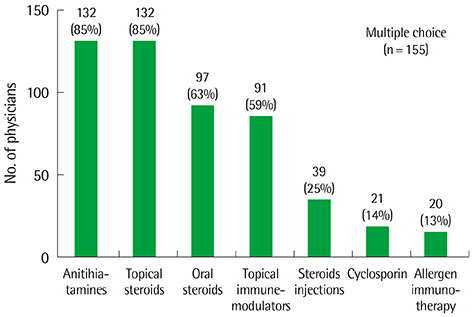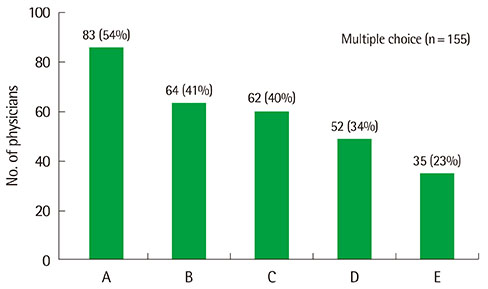Status of clinical practice on diagnosis and management of atopic dermatitis in Korea: a questionnaire survey of physicians
- Affiliations
-
- 1Department of Pediatrics, Wonkwang University Sanbon Hospital, Wonkwang University College of Medicine, Gunpo, Korea. pyallergy@gmail.com
- KMID: 2262969
- DOI: http://doi.org/10.4168/aard.2013.1.3.257
Abstract
- PURPOSE
The prevalence of atopic dermatitis (AD) has been increasing in many developed countries including Korea. There has been little information on the status of real clinical practice for atopic dermatitis by physicians in Korea.
METHODS
This study investigated the current status of clinical practice on allergy test and treatment of AD in Korea by analyzing a questionnaire survey of 155 physicians who attended the educational program for practical management of AD by the Korean Academy of Asthma, Allergy and Clinical Immunology. The questionnaire was mainly composed of 20 items regarding diagnosis, treatment of AD.
RESULTS
Among the 155 physicians who completed the questionnaire survey, most of subjects (90%) agreed that allergy test was necessary, but only 68% performed allergy test in their practice for AD. The barriers to allergy testing were lack of test personnel or facilities (61%), disbelief on the clinical importance of allergy test in the treatment (41%), and difficulty in explanation about the test results to patients (16%). Problems interfering the active treatment of patients with AD were the difficulty in acquiring a sufficient time for education and explanation about treatment (54%), incomplete clinical efficacy of current medication and concern on the side effects (41%), and the difficulty in establishing a good doctor-patient relationship (40%).
CONCLUSION
There are difficulties of physicians in the active management of AD in Korea. To solve current difficulties, changes in medical system to encourage the physicians' effort for active clinical practice for patients with AD and education for physicians are needed.
Keyword
MeSH Terms
Figure
Cited by 3 articles
-
Qualitative assessment of atopic dermatitis-related mobile applications in Korea
Dahee Jin, Tae Hoon Heo, Yoon Lee, Ji-Tae Choung
Allergy Asthma Respir Dis. 2014;2(5):370-376. doi: 10.4168/aard.2014.2.5.370.Multicenter questionnaires on the current management of atopic dermatitis in Korea
Dong Hun Lee, Eun Jin Doh, Jin Young Lee, Yang Park, Jae Won Oh, Mi Hee Lee, Soo Jong Hong, So-Yeon Lee, Joon Soo Park, Dong-Ho Nahm, Hye Yung Yum,
Allergy Asthma Respir Dis. 2016;4(4):271-275. doi: 10.4168/aard.2016.4.4.271.Current Management of Moderate-to-Severe Atopic Dermatitis: A Survey of Allergists, Pediatric Allergists and Dermatologists in Korea
Hye Yung Yum, Hyun Hee Kim, Hyun Jung Kim, Woo Kyung Kim, So-Yeon Lee, Kapsok Li, Dong Hun Lee,
Allergy Asthma Immunol Res. 2018;10(3):253-259. doi: 10.4168/aair.2018.10.3.253.
Reference
-
1. Laughter D, Istvan JA, Tofte SJ, Hanifin JM. The prevalence of atopic dermatitis in Oregon schoolchildren. J Am Acad Dermatol. 2000; 43:649–655.
Article2. Schultz Larsen F, Hanifin JM. Secular change in the occurrence of atopic dermatitis. Acta Derm Venereol Suppl (Stockh). 1992; 176:7–12.3. Hong SJ. Korean ISAAC Study Group of Korean Association of Allergy and Respiratory Diseases. Report of Korean ISAAC epidemiologic study for asthma and allergic diseases in children. Pediatr Allergy Respir Dis. 2007; 17:Suppl 1. S55–S66.4. Williams H, Stewart A, von Mutius E, Cookson W, Anderson HR. International Study of Asthma and Allergies in Childhood (ISAAC) Phase One and Three Study Groups. Is eczema really on the increase worldwide? J Allergy Clin Immunol. 2008; 121:947–954.e15.
Article5. Leung DY, Boguniewicz M, Howell MD, Nomura I, Hamid QA. New insights into atopic dermatitis. J Clin Invest. 2004; 113:651–657.
Article6. National Health Insurance Corporation [Internet]. Seoul: National Health Insurance Corporation;c2000. cited 2012 Sep 24. Available from: http://www.nhic.or.kr./cms/board/board/Board.jsp?act=VIEW&communityKey=B0039&boardId=22557.7. Oh JW. Recent situation of the management of atopic dermatitis. Korean J Asthma Allergy Clin Immunol. 2012; 32:14–15.8. Lee JB, Rha YH, Choi SH. A questionnaire survey of care-givers' understanding of atopic dermatitis. Korean J Asthma Allergy Clin Immunol. 2009; 29:179–185.9. Kim HB, Cho YJ, Yoo KH, Kim DY, Kim J, Kim H, et al. Survey on the management of atopic dermatitis. Korean J Asthma Allergy Clin Immunol. 2012; 32:16–20.10. Kim JK, Kim JH, Lim DH, Son BK. Qualitative assessment of atopic dermatitis-related websites. Pediatr Allergy Respir Dis. 2007; 17:282–288.11. Lee HJ, Lee JH, Lee YW, Kim CW, Dhong HJ, Park HS, et al. Multicenter analysis of the current status of unproved complementary/alternative medicine other than herbal medication in allergy patients. Korean J Med. 2011; 80:68–77.12. Park JS, Kim BJ, Park Y, Lee SY, Kim WK, Kim JE, et al. KAAACI Work Group Report on the Treatment of Severe/Recalcitrant Atopic Dermatitis. Korean J Asthma Allergy Clin Immunol. 2010; 30:255–270.13. Rhim JW, Moon KS, Kong DY, Pyun BY. An Investigation into the actual condition of outbreak and treatment in atopic dermatitis. Pediatr Allergy Respir Dis. 2005; 15:44–52.14. Hanifin JM, Cooper KD, Ho VC, Kang S, Krafchik BR, Margolis DJ, et al. Guidelines of care for atopic dermatitis, developed in accordance with the American Academy of Dermatology (AAD)/American Academy of Dermatology Association"Administrative Regulations for Evidence-Based Clinical Practice Guidelines". J Am Acad Dermatol. 2004; 50:391–404.15. BuBmann C, Bieber T, Novak N. Systemic therapeutic options for severe atopic dermatitis. J Dtsch Dermatol Ges. 2009; 7:205–219.
Article16. Kim DH, Kang KH, Kim KW, Yoo IY. Management of children with atopic dermatitis. Pediatr Allergy Respir Dis. 2008; 18:148–157.
- Full Text Links
- Actions
-
Cited
- CITED
-
- Close
- Share
- Similar articles
-
- Current Status in Management of Children with Atopic Dermatitis and Knowledge and Practice of Preschool Teachers
- A Diagnostic Questionnaire for the Epidemiologic Studies of Childhood and Adult Atopic Dermatitis in Korea
- Measurement of Atopic Dermatitis Disability
- A Questionnaire Survey of Care-givers' Understanding of Atopic Dermatitis
- A Study on the Cell - Mediated Immunity of Patients with Apopic Dermatitis






